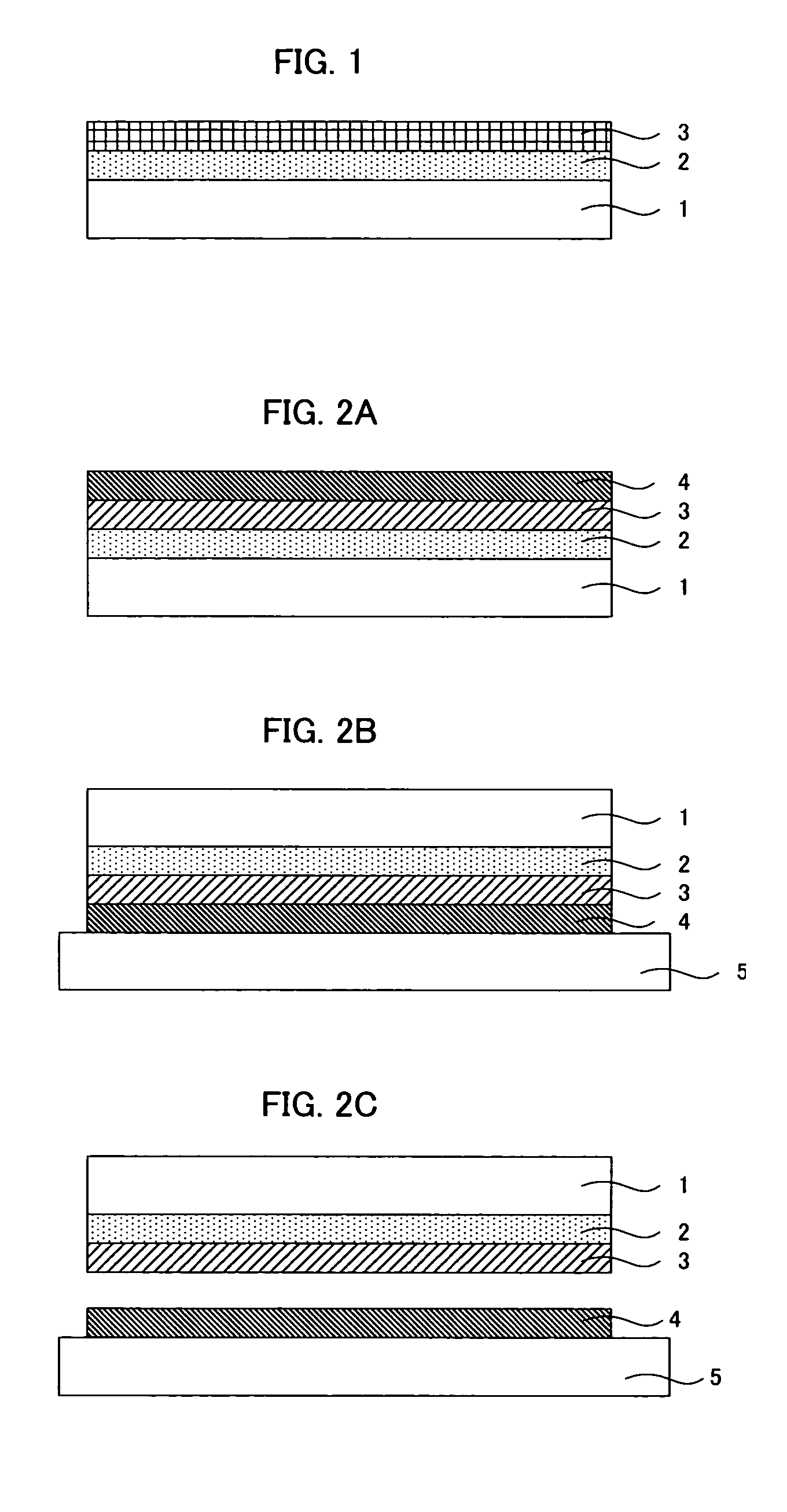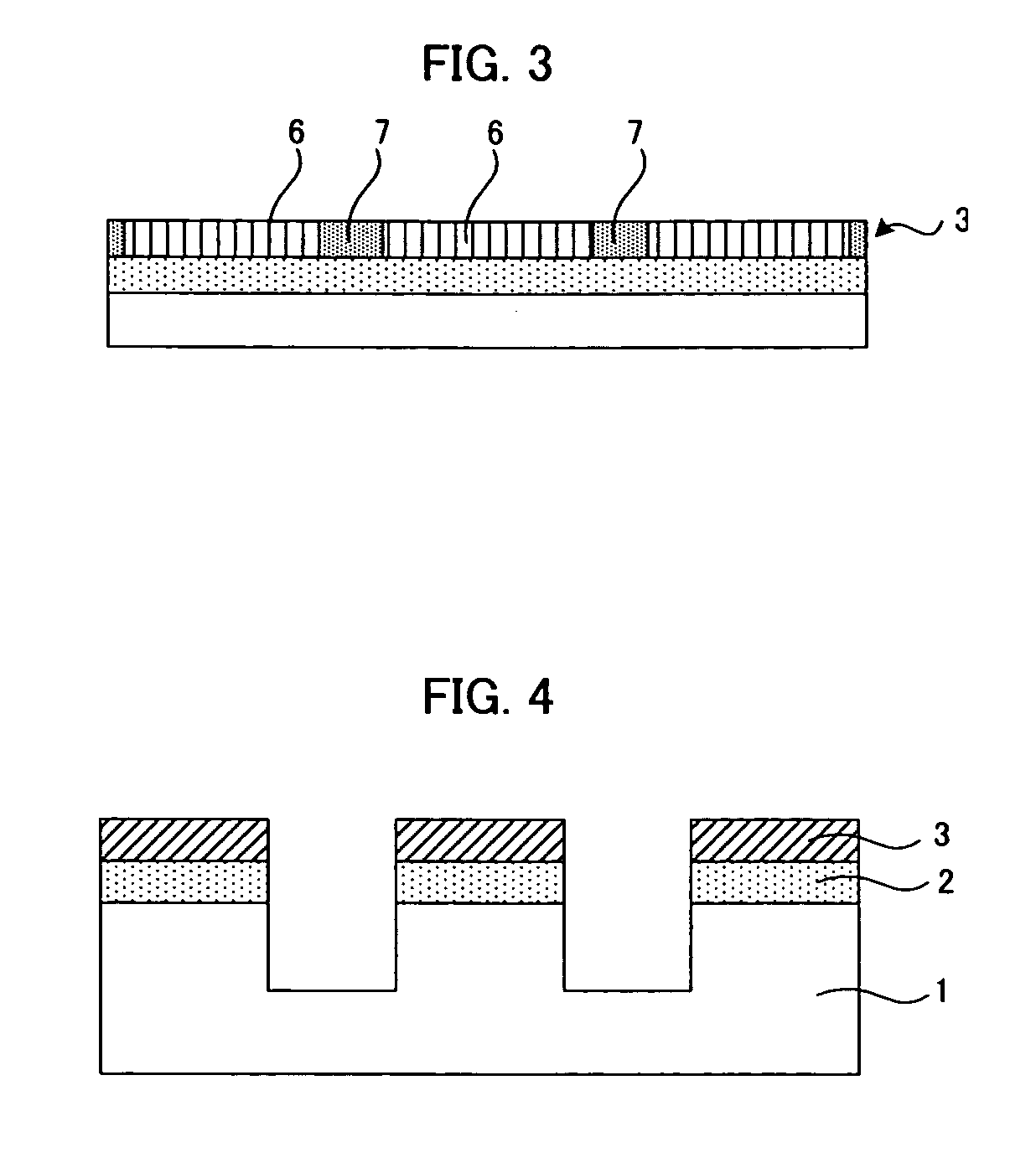Substrate for cell transfer
a cell transfer and substrate technology, applied in specific use bioreactors/fermenters, biomass after-treatment, biochemistry apparatus and processes, etc., can solve problems such as difficulty in evenly forming the cell transfer layer
- Summary
- Abstract
- Description
- Claims
- Application Information
AI Technical Summary
Benefits of technology
Problems solved by technology
Method used
Image
Examples
example 1
(Formation of the Intermediate Layer)
[0064] A 25 μm thickness polyester film was prepared. With the vacuum degree in a CVD chamber reduced to 4.0×10−3 Pa, an electric power (input electric power 300 W) having a 90 kHz frequency was applied to the electrode. Thereafter, a hexamethyl disiloxane, an oxygen gas and a helium gas were introduced by each predetermined amount, and the vacuum degree was controlled to be 30 Mpa. Thereby, a silicon oxide based thin film (intermediate layer) was formed by about 100 nm thickness by plasma-enhanced vapor deposition (CVD method).
(Formation of the Cell Transfer Layer)
[0065] 0.4 g of an organosilane TSL8114 (GE Toshiba Silicones) and 0.4 g of a fluoloalkyl silane TSL8233 (GE Toshiba silicones) were diluted by 5 g of an isopropyl alcohol and agitated for more than 15 minutes. A 1,3-butane diol was added to the above-mentioned solution and agitated for more than 15 minutes. The solution prepared accordingly was spin coated onto the above-mentione...
example 2
(Formation of the Intermediate Layer)
[0071] In the same manner as in the example 1, a 65 nm film thickness silicon oxide based thin film containing a methyl group (intermediate layer) was formed on a 150 μm thickness polyester film.
(Formation of the Cell Transfer Layer)
[0072] After cleaning the above-mentioned intermediate layer surface with ultraviolet ray, a coating agent, prepared by diluting a silane coupling agent XC98-B2474 (GE Toshiba Silicones) 10-fold with an isopropyl alcohol, was coated on the surface by spin coating. Subsequently, by drying at 150° C. for 10 minutes, a substrate for cell transfer, provided with the cell transfer layer, was obtained. The average value of the contact angle of the above-mentioned cell transfer layer with water was 101.8°.
(Production of the Photomask for the Exposure Treatment)
[0073] A photomask with the blood vessel pattern based on a human eyeground blood vessel photograph as the opening part was produced. A photocatalyst-containin...
example 3
(Formation of the Intermediate Layer)
[0077] An untreated polystyrene (PS) sheet having about a 20 mm diameter was prepared, and an intermediate layer was formed by the same method as in the example 1. By the oxygen plasma treatment, a silanol group was provided on the film surface.
(Formation of the Cell Transfer Layer)
[0078] The above-mentioned treated PS sheet was soaked quickly in a toluene solution (3% concentration) of a γ-methacryloxy propyl trimethoxy silane (GE Toshiba Silicones) for 2 hours. Thereafter, it was cleaned with a toluene and dried with a nitrogen gas. Subsequently, with the PS sheet placed in a 35 mm dish, a solution, prepared by diluting an N-isopropyl acrylic amide with an isopropyl alcohol to 55%, was spread on the above-mentioned PS sheet. By the electron beam irradiation to the PS sheet and further cleaning with water, a cell transfer layer comprising a poly (N-isopropyl acrylic amide) layer was formed on the intermediate layer.
(Exposure Treatment of ...
PUM
| Property | Measurement | Unit |
|---|---|---|
| contact angle | aaaaa | aaaaa |
| contact angle | aaaaa | aaaaa |
| surface tension | aaaaa | aaaaa |
Abstract
Description
Claims
Application Information
 Login to View More
Login to View More - R&D
- Intellectual Property
- Life Sciences
- Materials
- Tech Scout
- Unparalleled Data Quality
- Higher Quality Content
- 60% Fewer Hallucinations
Browse by: Latest US Patents, China's latest patents, Technical Efficacy Thesaurus, Application Domain, Technology Topic, Popular Technical Reports.
© 2025 PatSnap. All rights reserved.Legal|Privacy policy|Modern Slavery Act Transparency Statement|Sitemap|About US| Contact US: help@patsnap.com


